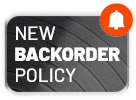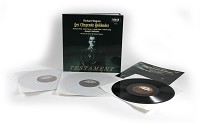Joseph Keilberth - Wagner: The Flying Dutchman
(Stereo Version)
| Label: |
Testament (Decca) |
| Genre: |
Classical |
| Product No.: |
ADEC 1384
|
| UPC: | 749677138417 |
| Availability: |
Back Ordered
|
| Category: |
180 Gram Vinyl Record |
| No. of Discs: | 3 |
This item is Back Ordered and currently unavailable.
Please inform me of any status changes for this product regarding its upcoming availability.
One of the most acclaimed Wagner productions of the postwar period, The Flying Dutchman features a breathtakingly intense opera performance, here by the Bayreuth Festival Chorus and Orchestra under the baton of Joseph Keilberth as it was recorded live in 1955 IN STEREO by Kenneth Wilkinson. This three-LP box set includes a detailed 28-page booklet with information and pictures to satisfy any enthusiast. Typical of most Deccas and Wilkinson efforts, the recording quality is outstanding, and the remastering job for this 2007 issue does not disappoint.
At Bayreuth, Decca and their German subsidiary Teldec had already recorded Parsifal and an unreleased Ring Cycle in 1951, and Lohengrin in 1953. During the "off" years of 1952 and 1954 they had negotiated unsuccessfully with Wolfgang Wagner of the Festival management and with EMI to record the Ring under Joseph Keilberth. The project foundered on the seven-year exclusivity clause that EMI had established over Bayreuth performances of the work, when they released an act of the Ring from the 1951 Festival. Wolfgang, however, had backed Decca's case as much as he could and readily gave his assent to a recording of his new production of Der fliegende Hollander (The Flying Dutchman), which opened the Festival in 1955. The company had already established a successful microphone placing for recording at the Festspielhaus in mono – largely due to the placement by engineer Kenneth Wilkinson of a single English RK2 condenser microphone high up in the theatre. "In view of Decca's sound, I fear competition when our own records are released," Walter Legge had minuted EMI's internal departments in 1952. Now in 1955 Decca planned to extend their operations by experimentally taping the performances in stereo as well, using further cunning microphone placings by engineer Roy Wallace. At some point in the spring of 1955 they believed, mistakenly, that a legal loophole had been found in EMI's 1951 exclusivity clause, and decided to record the Ring as well, although after the tapes had been edited back in West Hampstead, the project was again shelved, probably because of John Culshaw's already declared campaign to make a studio cycle with Solti and the Vienna Phiharmonic.
| 1. Overture | 2. Act One, Scene One/ Erster Aufzug, Erste Szene | 3. Act One, Scene Two/ Erster Aufzug, Erste Szene | 4. Act One, Scene Three (beginning)/ Erster Aufzug, Dritte Szene (Anfang) | 5. Act One, Scene Three (concluded)/ Erster Aufzug, Dritte Szene (Ende) | 6. Act Two, Scene One (beginning)/ Zweiter Aufzug, Erste Szene (Anfang) | 7. Act Two, Scene One (concluded)/ Zweiter Aufzug, Erste Szene (Ende) | 8. Act Two, Scene Two / Zweiter Aufzug, Zweite Szene | 9. Act Two, Scene Three (beginning)/ Zweiter Aufzug, Dritte Szene (Ende) | 10. Act Two, Scene Three (concluded)/ Zweiter Aufzug, Dritte Szene (Ende) | 11. Act Three, Scene One (beginning)/ Dritter Aufzug, Erste Szene (Anfang) | 12. Act Three, Scene One (concluded)/ Dritter Aufzug, Erste Szene (Ende) | 13. Act Three, Scene Two / Dritter Aufzug, Zweit Szene |
|
View other items by Joseph Keilberth |
|
 In-Stock Music Orders Over $99 SHIP FREE Within The Continental U.S.
In-Stock Music Orders Over $99 SHIP FREE Within The Continental U.S.







 Login
Login
 My Account
My Account
 Cart
Cart Wishlist
Wishlist
 Contact
Contact





